|
|
|
Sort Order |
|
|
|
Items / Page
|
|
|
|
|
|
|
| Srl | Item |
| 1 |
ID:
182634


|
|
|
|
|
| Summary/Abstract |
China has prioritized quantum science and technology as a critical frontier for its national security and development. To date, Chinese research has already reached a leading position within the discipline, enabled by state support and funding, as well as the recruitment and cultivation of talent. The rapid advances on this front can provide a valuable illustration of the dynamics of China’s evolving innovation ecosystem, including the increased prominence of leading technology companies, and even start-ups, as serious contenders. China’s strategy of military–civil fusion, which aims to create a more integrated ecosystem in science and technology, can contribute to enabling progress in dual-use developments. This case study draws upon the shared framework for this special issue, which provides a method by which to consider the factors that enable defense innovation. Looking forward, these advances could prove consequential for the future strategic balance between China and the United States.
|
|
|
|
|
|
|
|
|
|
|
|
|
|
|
|
| 2 |
ID:
182628
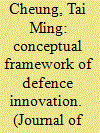

|
|
|
|
|
| Summary/Abstract |
Gaining a decisive technological edge is a never-ending pursuit for defence establishments. Intensifying geo-strategic and geo-economic rivalry among major powers, especially the U.S and China, and the global technological revolution occurring in the civilian and military domains, promise to reshape the nature and distribution of global power. This article provides a conceptual framework for a series investigating the state of global defence innovation in the twenty-first century. The series examines defence innovation in small countries with advanced defence innovation capabilities (Israel, Singapore), closed authoritarian powers (North Korea, Russia), large catch-up states (China and India) and advanced large powers (U.S.).
|
|
|
|
|
|
|
|
|
|
|
|
|
|
|
|
| 3 |
ID:
182633
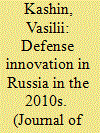

|
|
|
|
|
| Summary/Abstract |
The chapter examines the driving forces and the institutions behind the Russian military buildup in the period between 2010 and 2020. The beginning of the rapid Russian military modernization in late 2000s was the result of the shifting threat assesments by the Russian political leadership and the painful lessons of the war with Georgia in 2008. Russia had to conduct an throughout and painful restructuring of the military institutions and the defense industrial complex in order to be able to meet the ambitious goals of its’ rearmament program. The result was significant growth in the Russian military capabilities by the middle of the decade.
|
|
|
|
|
|
|
|
|
|
|
|
|
|
|
|
| 4 |
ID:
182631
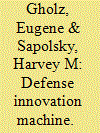

|
|
|
|
|
| Summary/Abstract |
American security policy discussions commonly warn that the United States is falling behind technologically, especially vis-à-vis China. However, the U.S. military remains at the cutting edge because of its well-developed defense innovation system. No nation (or combination) comes close to U.S. investment in defense R&D. Unmatched political concerns about avoiding casualties, inherent rivalry among participants in the U.S. defense innovation system, and traditional American openness to immigration and new ideas drive the investment. The overly alarmist warnings come from a thriving threat assessment system that continually searches for potential military dangers and technological challenges. The warnings feed the defense innovation system.
|
|
|
|
|
|
|
|
|
|
|
|
|
|
|
|
| 5 |
ID:
182630
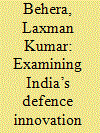

|
|
|
|
|
| Summary/Abstract |
India has expended a great deal of energy and resources to set up a vast defence economy to innovate state-of-the-art weapon systems. However, the performance of the defence economy has been largely suboptimal. An examination of the causes of poor performance exhibits a number of shortcomings related to India’s both ‘hard’ and ‘soft’ innovation capacities. Lack of strong support from higher political leadership, meager research and development (R&D) and procurement budgets, inefficiency of the main R&D and manufacturing players, poor management of human resources and a weak acquisition system, among others, leave India’s defence innovation in a poor state.
|
|
|
|
|
|
|
|
|
|
|
|
|
|
|
|
| 6 |
ID:
182632


|
|
|
|
|
| Summary/Abstract |
Both Israel and Singapore engage in military-technological innovation in areas deemed critical to strategic sovereignty. Both countries have consistently championed high levels of funding for military R&D and for maintaining and nurturing indigenous defense industries. Both countries have, to a varying degree, also strongly supported the cultivation of local S&T, including the spin-on of commercial high-technology breakthroughs into the defense sector. Israel has been more successful when it comes to military-technological innovation, mostly because it has to: its strategic situation is much more tenuous than Singapore’s. Singapore, on the other hand, faces much less of an existential threat, and so its military-technological innovation activities are more one of desire than necessity.
|
|
|
|
|
|
|
|
|
|
|
|
|
|
|
|
| 7 |
ID:
182629
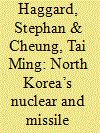

|
|
|
|
|
| Summary/Abstract |
North Korea’s strategic weapons innovation system is exemplary of an authoritarian mobilization model. The top leadership prioritizes the program and mobilizes the country’s science, technology, and heavy industrial resources around key programs. Key to success are investments in a defense industrial infrastructure that runs from basic research and development to applied R&D, product development, and linked production capability. Although foreign borrowing is important, the country’s nuclear and missile programs would not have gelled in the absence of complementary domestic investments.
|
|
|
|
|
|
|
|
|
|
|
|
|
|
|
|
|
|
|
|
|